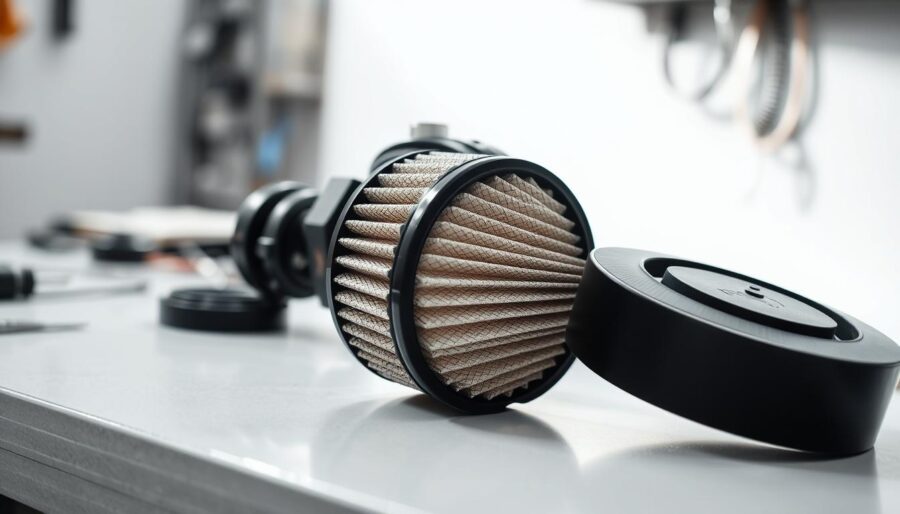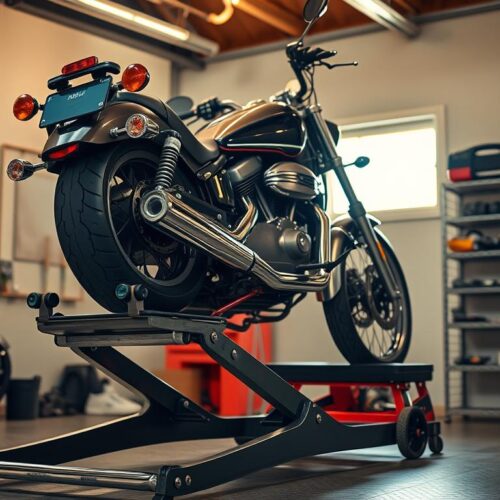Maintaining your motorcycle’s air filter in top condition is key. A clean filter boosts airflow, fuel efficiency, and reduces engine wear. This guide explains how to clean and replace your motorcycle air filter. You’ll learn about different air filter types, needed tools, and tips to keep your bike reliable on the road.
Importance of Motorcycle Air Filter Maintenance
Keeping your motorcycle’s air filter in good shape is key for its best performance. It makes sure your bike works well, giving your engine the power it needs. A clean filter means more air for the engine, which helps it burn fuel better. This gives you perks like better gas mileage and cleaner emissions.
Ignoring your air filter, though, can cause lots of problems. A dirty filter blocks air from getting in, leading to engine troubles. You might notice your bike runs unevenly or uses more gas. Over time, it can even damage the engine. Keeping your air filter clean avoids these issues, keeping your ride smooth.
Types of Motorcycle Air Filters
Understanding motorcycle air filters can boost your ride and engine’s power. Each type has benefits for different conditions and tastes.
Foam air filters are a go-to for riders in dusty places. They last long and filter well but need regular oiling. This makes them a top pick for off-roading lovers.
Paper air filters are cheaper and easy to throw away. They suit street bikes and casual riders who like easy upkeep. Though their filtration isn’t as good as foam, they’re still a popular choice.
If you want better performance, dual layer filters are the way to go. High-end bikes often have these, mixing materials for the best airflow and filter quality. This type keeps your engine getting clean air, boosting its power.
| Type of Filter | Benefits | Maintenance | Best For |
|---|---|---|---|
| Foam Air Filters | Reusable, effective in dusty conditions | Regular oiling required | Off-road riding |
| Paper Air Filters | Affordable, easy maintenance | Disposable | Street bikes |
| Dual Layer Filters | Enhanced airflow, better filtration | Varies by manufacturer | High-performance bikes |
When to Clean Your Motorcycle Air Filter
Knowing when to clean your motorcycle air filter is key to keep it running well. Look out for signs like less gas mileage, the engine not running smoothly, or odd sounds while you’re riding. It’s important to regularly check this.
Cleaning times for air filters can vary from 3,000 to 6,000 miles. If you ride in tough spots, like off-road paths or in heavy rain, you might need to clean it more. Also, don’t forget to do it with the change of seasons. Things like more dust in the summer or moisture in winter can make a big difference.

Tools and Materials Needed for Cleaning
To clean your motorcycle’s air filter well, you’ll need the proper tools for air filter cleaning and items. Start with a soft brush to take off debris from the filter. Mild dish soap works well for regular cleaning, and products like K&N Cleaner are great for foam and cotton filters. Use a basin to soak the filters in the solution easily.
Don’t forget your safety gear. Wear gloves and goggles to keep harmful chemicals and dust away from your hands and eyes. With these tools and materials ready beforehand, your cleaning job will be easier. This way, your air filter will stay in top shape.
Step-by-Step Guide to Cleaning Air Filters
A clean air filter is key to keeping your motorcycle running well. This guide will help you clean both foam and paper filters right. First, gather your tools and materials.
- Soak: Put the foam filter in a special cleaning solution. Let it sit for a few minutes.
- Rinse: Rinse the foam gently under water to get rid of dirt. Don’t use strong water pressure; it can hurt the filter.
- Drying: Let the filter air-dry. Make sure it’s fully dry before you oil it.
- Oil: Once dry, spread a thin layer of filter oil evenly. This improves filtration.
When cleaning paper filters, the steps are different. Pay attention to protect your filter:
- Inspection: First, look for any damage. Replace the filter if it’s badly stained or torn.
- Rinse: Rinse the filter gently with water. A soft spray helps get rid of dirt without damage.
- Drying: Air-dry paper filters too, to avoid damage from heat.
Follow this guide to keep your air filters working great. Clean filters boost airflow and make your engine run better. Always dry filters well to keep them working right.
How to Replace Your Air Filter
Cleaning might not be enough, and you might need to change your air filter. Knowing when to replace it is key to keeping your motorcycle running well. Look out for signs like visible damage, much wear, or lower engine power. A step-by-step method makes changing the filter easy.
To replace your air filter without trouble, just follow these steps:
- Ensure your motorcycle is turned off and placed on a stable surface.
- Access the airbox according to your specific owner’s manual.
- Carefully remove the old air filter, taking precautions to avoid introducing debris into the airbox.
- Inspect the airbox for cleanliness. This step maximizes airflow and overall engine performance.
- Insert the new air filter, making sure it fits snugly and securely.

By following this guide, your motorcycle will keep running smoothly, with good performance and a longer life.
Additional Maintenance Tips for Motorcycle Care
Maintaining your motorcycle is more than just cleaning the air filter. It involves a mix of steps that cover your bike’s whole system. You should regularly check spark plugs, oil, and brakes to keep things running smoothly.
Taking care of the engine is super important. Make sure the lubrication and cooling systems are working right. This can make your bike last a lot longer. These systems help avoid big problems later on.
Keeping the intake system clean is crucial, too. Dirt and debris can lower performance and fuel efficiency. Cleaning it regularly will ensure your bike stays in top shape.
With these extra steps in your maintenance routine, your motorcycle care will be top-notch. It helps your bike be more reliable and last longer.
Environmental Considerations
Being mindful of the environment while taking care of your motorcycle improves both your experience and our future. It’s key to use eco-friendly cleaning methods. Try biodegradable soaps or cleaners made for air filters to lessen harm to nature.
These green cleaners help the earth while keeping your bike running well.
It’s crucial to dispose of filters the right way. Many filters, whether paper or foam, can be recycled. Take them to recycling centers for safe disposal.
Properly getting rid of filters cuts down on environmental harm. This thoughtful act reduces waste and helps keep the planet clean.
Choosing eco-friendly products and disposing of filters correctly shows your respect for the environment. It keeps your motorcycle in great shape, too.
| Practice | Description | Environmental Impact |
|---|---|---|
| Eco-Friendly Cleaning | Using biodegradable soaps and air filter-specific cleaners | Minimizes harmful effects on ecosystems |
| Proper Filter Disposal | Recycling or safe disposal of old filters | Reduces waste and champions sustainability |
Conclusion: Ensuring Your Bike Breathes Right
Keeping your bike’s air filter clean is crucial, not just a small task. It’s key for your motorcycle’s performance and long life. A clean air filter lets your engine get the right amount of air. This leads to better fuel use and a smoother ride. So, taking care of your air filter can save you money on repairs and keep your bike running well.
It’s very important to regularly clean or change your air filter. Doing this can make your engine run better and last longer. By being proactive, you make sure every ride is smooth and enjoyable.
Think of your motorcycle as an investment that needs proper care. Following these steps will help your bike perform its best. With ongoing maintenance, you can enjoy great rides for many years.




